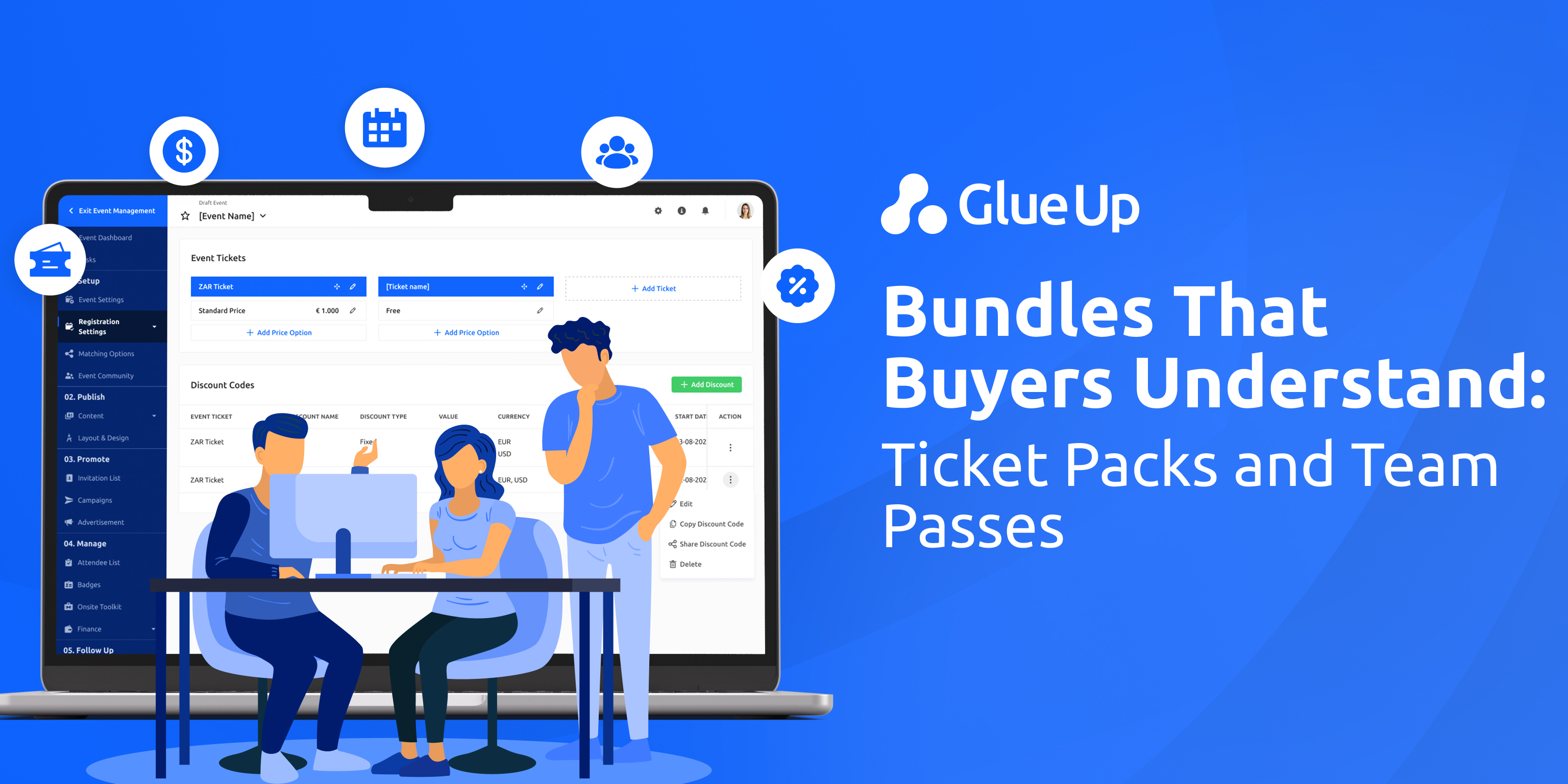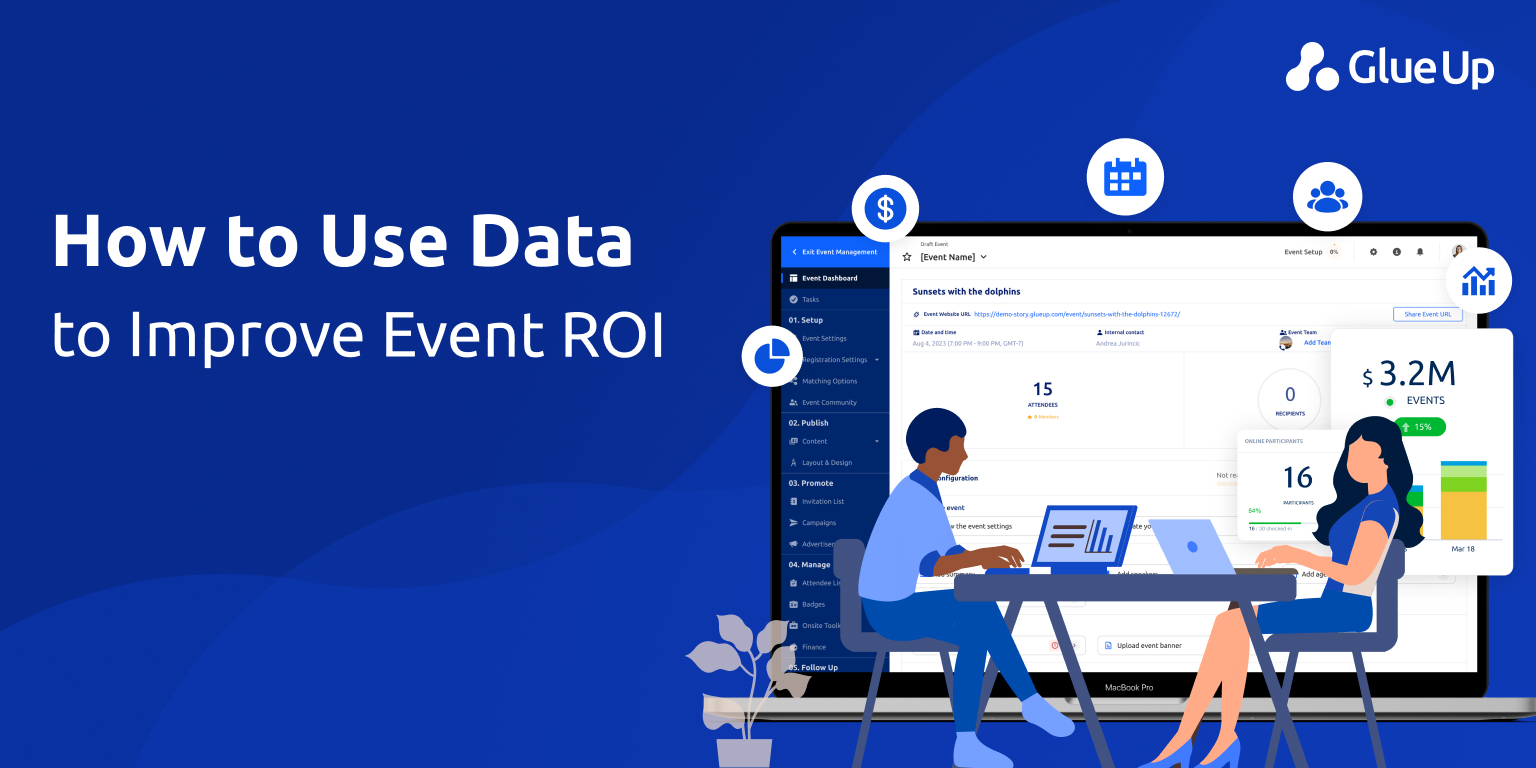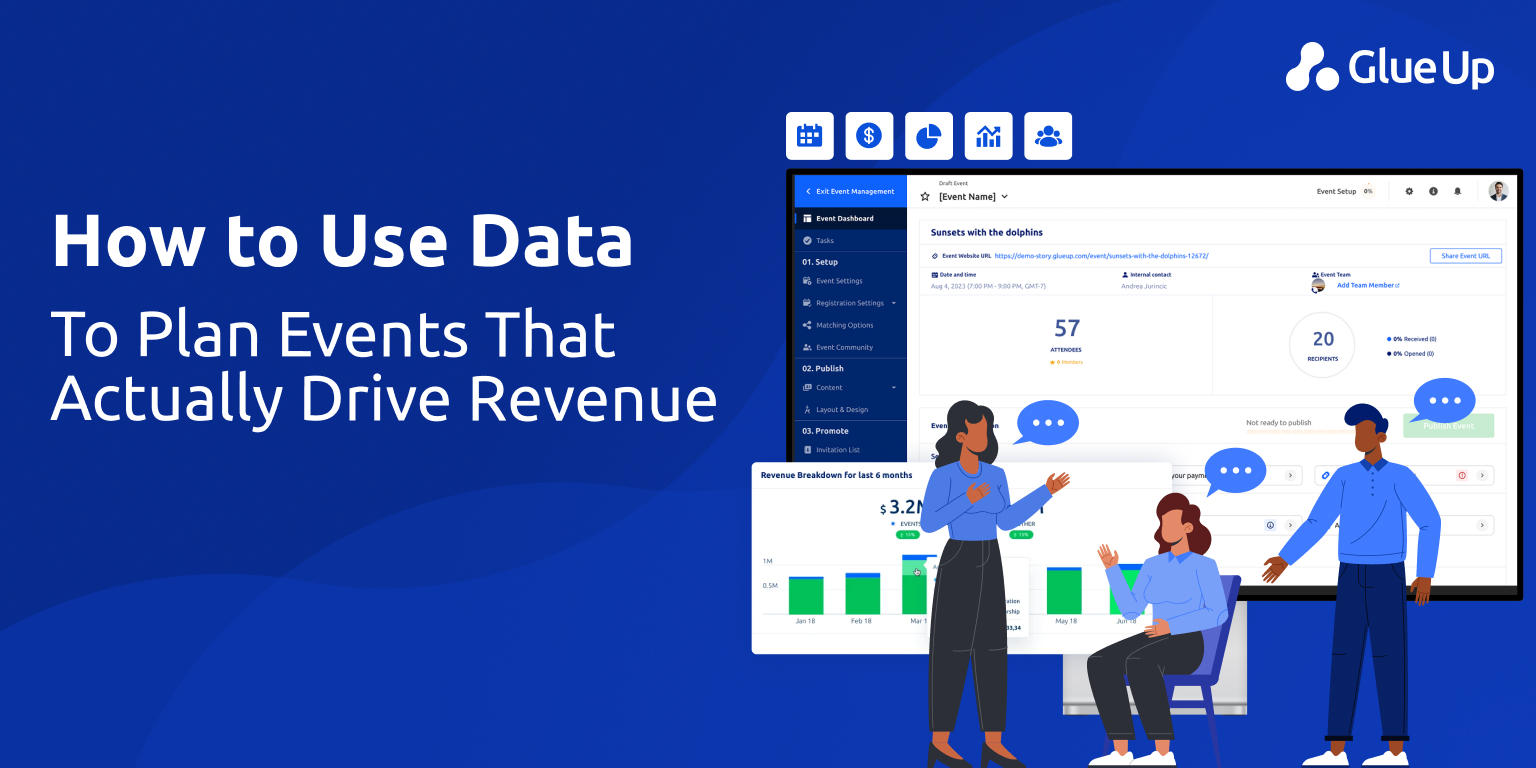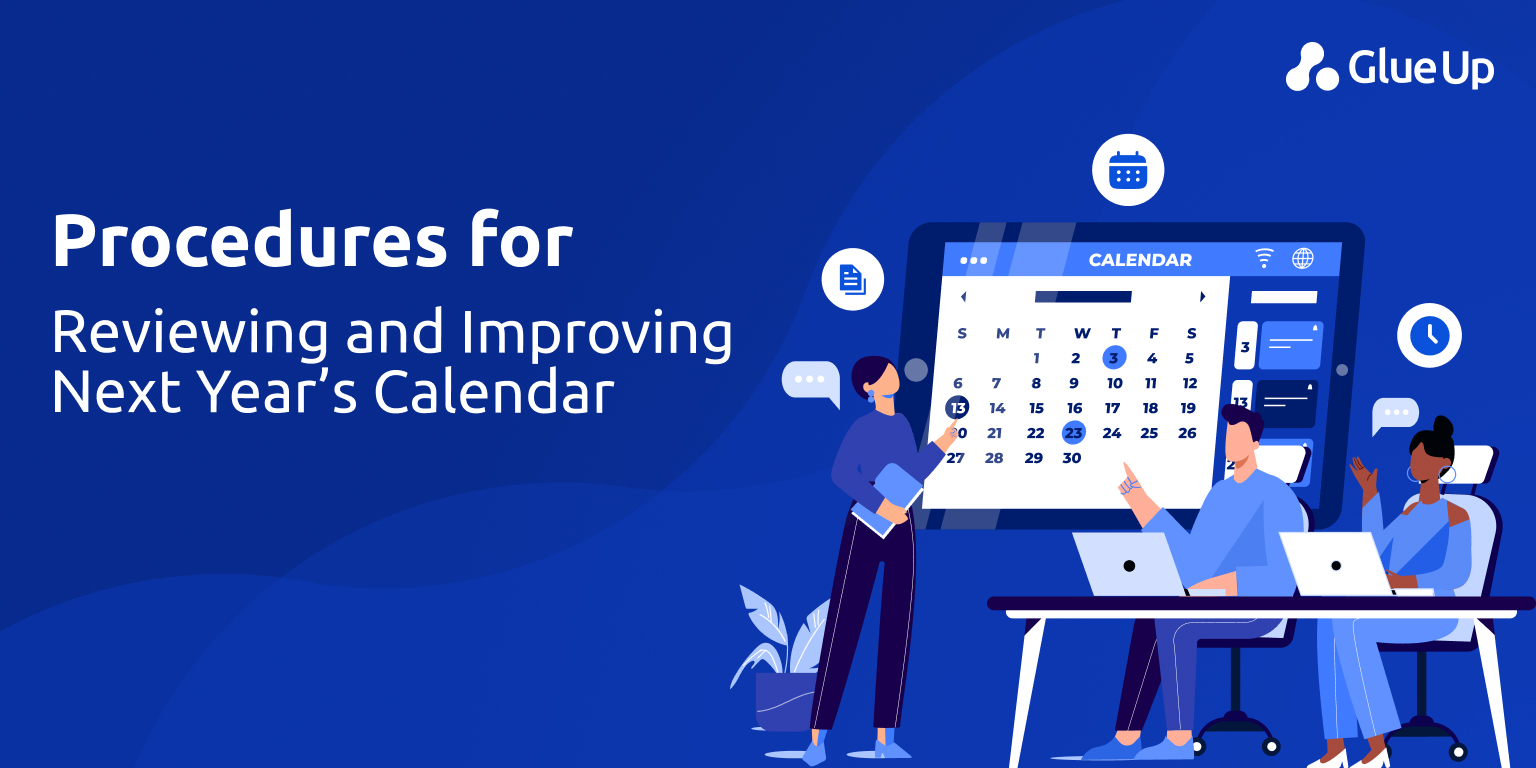
Every event planner knows the feeling: Tickets go on sale, your calendar looks full, and yet something feels off. The bundles aren’t selling. The “Ultimate VIP Experience” sits untouched, your flex pack confuses even staff, and the only buyers converting are those grabbing single-day tickets.
It’s not because people don’t want value. It’s because they don’t understand it.
In 2025, when attention is fragmented, budgets tight, and loyalty short, event package design has quietly become one of the most underestimated growth levers for associations and membership organizations. The way you bundle, price, and present your passes now decides whether your next event season runs at a profit, or a polite loss disguised as engagement.
Glue Up helps member-based organizations solve that very problem. Beyond registrations and check-ins, the platform brings structure and science to the art of bundling: flex passes, weekend passes, season passes, all designed with behavioral logic that buyers instinctively “get.”
Let’s unpack how modern event package design works, why buyers misread most bundles, and how associations can turn passes into predictable revenue engines.
Key Takeaways
The most effective bundles start with how people make decisions. Flexibility, fairness, and simplicity shape conversion far more than discounts or perks. Glue Up helps associations translate behavioral principles into real package structures that buyers intuitively understand.
Across industries, these three formats consistently perform: flex passes reduce risk and drive early revenue, weekend passes focus engagement into high-value moments, season passes build loyalty and predictability. Glue Up enables all three with customizable redemption rules, swap options, and automated analytics.
Hiding fees or overcomplicating tiers kills trust. Associations that use clear, all-inclusive pricing and logical fences (seat zones, blackout dates, timing) outperform those chasing dynamic gimmicks. Glue Up’s pricing engine makes transparent pricing and tier logic easy to maintain.
The success of any bundle depends on redemption, not just sales. With Glue Up, associations automate reminders, redemption nudges, swap approvals, and performance tracking, keeping buyers engaged and ensuring bundles deliver real attendance.
You can’t optimize what you can’t measure. Tracking take rates, redemption curves, upgrade attach rates, and member satisfaction reveals which bundles drive the highest lifetime value. Glue Up unifies these insights across membership, events, and finance, turning bundling from guesswork into strategy.
Quick Reads
The Bundle Paradox: When “Options” Kill Clarity
Associations often believe more options equal more conversions. But behavioral economics tells a different story.
When researchers once offered shoppers 24 types of jam, only 3% made a purchase. When they offered just six, 30% did. The same principle applies to event passes: too many options, and people freeze.
Bundling was invented to simplify decisions, yet most event bundles do the opposite. Instead of creating clarity, they overwhelm.
You’ve seen this before, four flex passes, two tiers of VIP, a hybrid access pass, and a mysterious “executive pack” buried at checkout. Buyers get analysis paralysis, second-guess what they need, and either default to the cheapest ticket or abandon the cart entirely.
The fix starts with reframing event package design as communication. Each bundle must say something clear:
“I’m for people who want flexibility.”
“I’m for people attending all weekend.”
“I’m for loyal members who want everything.”
If your bundle can’t finish that sentence, it’s noise.
How Buyers Actually Think
When a prospective attendee scrolls your registration page, they’re not comparing features. They’re running an internal algorithm: “Which of these will I actually use? How likely am I to regret this later?”
Here’s the psychology you’re designing for:
Risk and flexibility: Nobody wants to prepay for an experience they might miss. That’s why bundles with clear swap or redemption options outperform rigid “all-in” passes.
Fairness: People will forgive high prices if they feel rules are transparent. Hidden fees or blackout clauses kill trust.
Cognitive load: The more a buyer must read to “get it,” the faster conversion drops.
Anchoring: Every buyer uses one visible price, usually GA tickets, as their mental anchor. All other prices are judged against it.
Redemption bias: People systematically overestimate how many events they’ll attend. That’s why reminder systems matter as much as pricing itself.
Glue Up’s platform quietly handles most of these friction points. Its flexible pass configurations let associations create swap windows, send automated reminders, and set transparent fences, all while maintaining unified data visibility across membership, events, and finance.
The Three Bundle Models Every Organization Should Master
1. Flex Passes: Freedom Without Chaos
Flex passes, sometimes called voucher packs, let buyers purchase a set number of “credits” (say, any 4 out of 10 events).
Why they work: They remove the biggest psychological barrier: commitment fear. Buyers feel they’re getting control over when and where they attend. For associations, this model keeps cash flow early and attendance steady throughout the season.
Best practices for design:
Allow redemptions up to 72 hours before the event.
Make seat categories consistent (Band A, B, C) to avoid confusion.
Limit SKUs, usually two or three flex options max.
Automate reminders like, “You’ve got 2 unused passes this quarter.”
What Glue Up enables: The system automates swap logic, tracks redemption rates, and shows analytics on unused credits, letting your team adjust in real time instead of waiting until post-season reports.
2. Weekend Passes: Concentrated Value
Weekend passes are the emotional middle ground between impulse and loyalty. They bundle multiple sessions or days into one clean promise: “Everything this weekend for one price.”
Why they work: They create urgency (“use it now or lose it”) and focus value on a short, memorable timeframe. Ideal for festivals, conferences, or regional events where people prefer immersive attendance.
Design strategies:
Anchor the weekend pass at roughly 2× the daily ticket.
Include tangible perks, early entry, lounge access, exclusive networking mixers.
Publish a clear schedule upfront so buyers visualize what they’re buying.
Offer early-bird and last-call windows to maximize both momentum and margin.
With Glue Up, planners can group sessions under one pricing umbrella, automate capacity management, and link benefits like session access or meal entitlements directly to pass type.
3. Team or Season Passes: Habit and Predictability
Season or annual passes turn attendance into habit. Buyers commit once and enjoy access all year, often with limited blackout dates or premium perks.
Why they work: They provide predictability for both you and the buyer. Associations lock in upfront revenue, while members lock in savings and identity. In sports, arts, and cultural events, this model is synonymous with loyalty.
Smart design moves:
Announce blackout dates before purchase.
Offer monthly payment options with a small upfront deposit to reduce churn.
Include “bring-a-friend” tokens to expand reach organically.
Cap VIP inventory to maintain exclusivity.
Glue Up’s recurring payment automation and tiered membership management make this easy. Finance, CRM, and events modules stay in sync.
Building Fairness and Fences into Pricing
Fair pricing is about being clear. The world’s most successful event organizers use “price fences”, rules that separate value tiers logically.
Examples include:
Timing fences: Early bird vs. regular windows.
Seat fences: Premium versus general seating.
Quantity fences: Discounts for 3+, 5+, or 10-event packages.
Access fences: Lounge, backstage, or hospitality perks.
A well-fenced offer prevents resentment. The buyer sees the trade-off and chooses knowingly.
Glue Up’s dynamic pricing tools let you apply these fences without complexity. You can set early-bird expiry, assign access rules, and even simulate pricing outcomes across bundles, all from one dashboard.
Anchoring: The Secret Weapon in Event Package Design
Anchoring is behavioral shorthand for “the first price you see sets the bar.” If your GA ticket is $100, and your VIP is $250, people perceive VIP as premium but attainable. If VIP is $700, it suddenly feels exploitative.
The trick is to anchor around logical multiples:
Flex Pass = 3.8× GA (four events)
Weekend Pass = 2× GA (two days)
VIP or Premium = 4–5× GA (all-in perks)
These ratios help buyers navigate fairness intuitively.
Glue Up’s pricing analytics help you visualize these anchors, tracking revenue per SKU and conversion correlation, so you can see which anchor points actually drive purchase decisions.
The Transparency Premium: Why Hidden Fees Backfire
Partitioned pricing, “$99 + fees”, once fooled buyers. Not anymore. In a world of reviews and screenshots, opacity is a reputational liability.
Buyers now reward brands that price transparently. They’ll pay slightly more if they feel respected. This is why associations using Glue Up often move to all-inclusive pricing: one clean number, taxes and fees folded in.
You get fewer support calls, fewer refund disputes, and far higher buyer satisfaction.
Where Dynamic Pricing Fits, and Where It Doesn’t
Dynamic pricing works brilliantly for single tickets where urgency is emotional. But in bundles, volatility breeds mistrust.
Use dynamic pricing to clear single-event inventory. Keep bundle pricing stable through each campaign cycle. Glue Up allows hybrid setups: dynamic singles, fixed bundles; so, teams can maximize revenue without confusing repeat buyers.
The stability of your bundles becomes a promise: the earlier you commit, the more predictable your cost.
Designing Add-Ons That Feel Earned
Event add-ons can turn a $300 pass into a $450 experience, if designed with integrity.
Examples that convert:
Seat upgrade tokens (use anytime).
“Bring-a-friend” credits (one per quarter).
Priority registration for sold-out sessions.
Hospitality packages for premium tiers.
Member-exclusive receptions or early networking hours.
Glue Up automates upsell logic, showing personalized add-on suggestions during checkout and tracking conversion performance so you can refine offers each cycle.
The Anti-Breakage Playbook
Unredeemed bundles, known as “breakage”, look good on spreadsheets but poison long-term loyalty. If 30% of your buyers never redeem, they’ll remember frustration, not value.
Combat this through:
Reminder automations (“You still have 2 unused events this season”).
Incentives for early redemptions (bonus drink vouchers, seat upgrades).
Simpler redemption UX (QR codes, mobile app access).
Glue Up’s integrated CRM and mobile app make redemption reminders seamless. Members get push notifications.
An Association That Filled Every Seat
One midsize professional association used Glue Up to overhaul its pricing model. Previously, it sold only single tickets. Attendance was sporadic, and revenue unpredictable.
They implemented three new packages:
Flex-3 Pass: Any 3 core events.
Weekend Pass: Full access to their annual summit.
Season Pass: Unlimited events with 2 blackout dates and monthly billing.
Results in 90 days:
Flex passes attracted new members who’d never attended before.
Season passes sold out in the first month, locking in 60% of annual revenue.
Redemption reminders lifted event attendance by 22%.
Staff hours spent on reconciliation dropped by half.
The combination of clear design and Glue Up’s automation turned what was once reactive event management into an operating rhythm, where revenue arrived early, attendance stayed high, and buyer satisfaction soared.
How to Measure Bundle Success
Every great event package design lives or dies on data. Track these:
Take rate per SKU – Which bundle drives most conversions?
Redemption rate – Are people using what they bought?
Upgrade attach rate – How often do buyers add perks?
Revenue per attendee – Does bundling lift ARPU or dilute it?
NPS by package – Which bundle actually creates loyalty?
Glue Up consolidates all these data points. You see real-time dashboards showing performance per bundle, revenue mix, and attendance pacing, allowing you to tweak pricing mid-campaign.
Launch, Learn, Iterate
The first version of your bundle is a hypothesis. The second is a system.
Start small, test three bundles. Run A/B tests on descriptions. Shorten copy, simplify terms. If one pass consistently converts higher, use it as your anchor and iterate around it.
Glue Up’s analytics let you segment by audience type: members, sponsors, first-timers; and learn which bundle structures each group prefers. Over time, you build a pricing memory unique to your organization.
That’s how event teams evolve from reactive planners to data-driven designers.
The Future of Event Package Design
The next wave of event packaging will merge membership, events, and engagement into one unified model.
Picture this:
Your members buy a “Connect Pass” that includes unlimited webinars, discounted workshops, and a set number of in-person events.
Their usage behavior automatically personalizes future offers.
Sponsorship tiers dynamically align with pass engagement data.
Glue Up is already paving that path. Its integrated CRM and event ecosystem allow associations to move beyond “selling tickets” to designing value ecosystems.
That’s what event package design will mean in the coming decade: bundles that evolve with the member.
Design Like You’re the Buyer
The secret to bundles buyers actually understand is empathy. If your event package design reads like legal fine print, it’s broken.
Simplify, clarify, and let automation do the heavy lifting. Keep your pricing transparent, your fences fair, and your redemption easy. That’s how associations grow not just attendance but trust.
Glue Up makes it possible. It gives associations the tools to design, test, and scale bundles that members love, accountants respect, and boards applaud.
Because the future of event revenue is about selling smarter.



